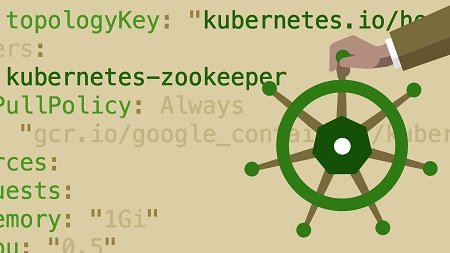
English | MP4 | AVC 1280×720 | AAC 48KHz 2ch | 2h 18m | 325 MB
Kubernetes is a core tool in DevOps, and is the world’s most popular open-source container orchestration engine. It offers the ability to schedule and manage containers (Docker or otherwise) at scale. This course introduces developers, DevOps engineers, and IT pros to Kubernetes, and offers a high-level discussion of orchestration and distributed systems. First, learn how to get a Kubernetes environment up and running on Mac or Windows using Minikube, and understand the components for Kubernetes. Next, deploy a sample Kubernetes application, and manage it using the Kubernetes dashboard. Instructor Karthik Gaekwad also shows how to deploy a more complicated application with a database and APIs. Then learn how to run jobs and cron jobs. Finally, explore more advanced topics on Kubernetes, including production deployments, namespaces, monitoring and logging, and authentication and authorization.
Topics include:
- What is containerization?
- Kubernetes features
- Clusters, nodes, and pods
- Deployments, jobs, and services
- Getting an application up and running
- Working with labels
- Handling application upgrades
- Dealing with configuration data
- Running jobs
- Production deployments
- Monitoring and logging
- Security in Kubernetes
Table of Contents
Introduction
1 Welcome
2 What you should know
3 How to use the exercise files
Containerization with Kubernetes
4 What is containerization
5 What is Kubernetes
6 Kubernetes features
7 Other implementations
Kubernetes – The Terminology
8 Architecture of a Kubernetes cluster
9 Basic building blocks – Nodes and pods
10 Deployments, jobs, and services
11 Labels, selectors, and namespaces
12 Kubelet and kube proxy
Kubernetes 101 – Hello World
13 Getting up and running – Mac install
14 Getting up and running – Windows install
15 Running a first Hello World application
16 Breaking down the Hello World application
17 Scaling the Hello World application
Making it Production Ready
18 Add, change, and delete labels
19 Working with labels
20 Application health checks
21 Handling application upgrades
22 Basic troubleshooting techniques
Kubernetes 201
23 Running a more complicated example
24 The Kubernetes dashboard
25 Dealing with configuration data
26 Dealing with application secrets
27 Running jobs in Kubernetes
28 Running stateful set applications
Advanced Topics
29 Production Kubernetes deployments
30 Detailed look at namespaces
31 Monitoring and logging
32 Authentication and authorization
Conclusion
33 Next steps
Resolve the captcha to access the links!